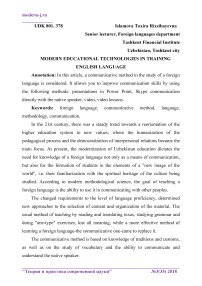Modern educational technologies in training English language
Автор: Islamova T.R.
Журнал: Теория и практика современной науки @modern-j
Рубрика: Основной раздел
Статья в выпуске: 3 (33), 2018 года.
Бесплатный доступ
In this article, a communicative method in the study of a foreign language is considered. It allows you to improve communication skills by using the following methods: presentations in Power Point, Skype communication directly with the native speaker, video, video lessons.
Foreign language, communicative method, language, methodology, communication
Короткий адрес: https://sciup.org/140272899
IDR: 140272899
Текст научной статьи Modern educational technologies in training English language
The communicative method is based on knowledge of traditions and customs, as well as on the study of vocabulary and the ability to communicate and understand the native speaker.
When studying a foreign language it is very important to have a lexical base. After all, the more lexical units are studied, the easier it becomes to communicate in the language being studied. Some students experience great difficulties in enriching the vocabulary. Some simply learn, the second build associations, and others glue the whole house with stickers with words of household use.
When teaching the task of the teacher - to check how well the student has memorized new words and expressions, idioms and phrase combinations. Within the traditional (grammatical-transfer) approach, control occurs in the form of translating a word from Russian into English and from English into Russian. While there is a more effective method that promotes both the memorization of words and the development of communication skills in a foreign language.
So, the teacher prepares the cards and divides the group into two teams. The student draws a card and explains the meaning of this word in a foreign language, at which time the student from the second team must guess and guess what this word is. Thus, there is a memorization of a new word, and communication in the studied language.
Another way to test the level of student training is the use of computer technology, or rather the Microsoft Power Point program.
The teacher shows on the slides pictures with pictures of objects. A student who calls this word, in English, gets one point. Or, the teacher demonstrates on the slides the explanation of new words in a foreign language, and assigns one point for each guessed word. Who will score more points (points), wins (you can put an estimate for this). Thanks to the spirit of competition, students will better learn the words at home and prepare for classes [2, 3-4] .
The tasks prepared by the teacher in the form of presentations allow to deepen and consolidate the knowledge gained earlier in the course of the usual lesson.
To improve the perception of students of foreign speech by ear, you can organize viewing various video materials (films, serials, talk shows, interviews) -both adapted and original (based on the level of student preparation).
Work with video includes three stages: pre-demonstration, demonstration and demonstration [1, 86] ..
Pre-demonstration stage.
This stage includes the preparation for film screening, namely, language difficulties are removed, new words are inserted and fixed, unintelligible colloquial formulas, linguistic-cultural realities are analyzed for students.
Demonstration stage.
Demonstration of the film must be accompanied by active educational activity of spectators-learners. Students can be offered a program to control the perception of the film in the form of annotation, a plan, supporting words, assignments.
The last stage of the demonstration.
At this stage, the effectiveness of using the guidelines of the perception of the film by the trainees suggested at the pre-demonstration stage is checked. Many critics of the communicative methodology say that using this method of teaching is very well spent on studying grammar and reading texts. Actually it is not. Grammar is studied intensively, but somewhat in a different form, namely the teacher gives the task to each group on the topic covered. Students do it themselves and then within the group discuss on the topic of the completed task and argue their choice. Working with the texts is also possible. For example, one student receives a text for reading and acquaintance on the theme of the architecture of England in the 18th century, the second student - about the architecture of Spain in the 18th century, the third - in Russia. Inside the group, students should give a short summary of the text and then discuss about the differences in architectural features of the countries in the 18th century. And, finally, one can organize conversations with a native speaker on Skype. All this leads to the fact that at present pedagogical activity should be innovative, which is one of the essential factors for the successful educational activity of any educational institution. This is one of the most effective ways to learn a foreign language. , that the communicative method is the most successful for mastering a foreigner's speech and the ability to communicate in a foreign language.
Список литературы Modern educational technologies in training English language
- Фарходжонова, Н. Ф. (2016). ПРОБЛЕМЫ ПРИМЕНЕНИЯ ИННОВАЦИОННЫХ ТЕХНОЛОГИЙ В ОБРАЗОВАТЕЛЬНОМ ПРОЦЕССЕ НА МЕЖДУНАРОДНОМ УРОВНЕ. InИнновационные тенденции, социально-экономические и правовые проблемы взаимодействия в международном пространстве (pp. 58-61).
- Коммуникативность обучения - в практику школы: Из опыта работы. Книга для учителя /(Под ред. Е.И.Пассова), Москва- Просвещение,1985
- Полат Е.С Новые педагогические и информационные технологии в системе образования. Москва: Издательский центр "Академия", 2000.


